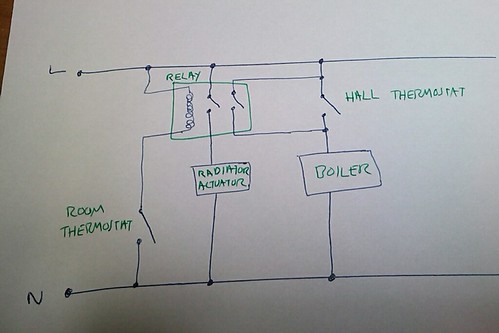I'm currently planning an upgrade for our ancient central heating system. We're renovating the livingroom at the moment and I want to install a room thermostat. I want the room thermostat to be able to both turn on the room's radiators and ask the boiler for more heat. I've found several radiator actuators which replace the TRV heads, which I'm planning to use.
To my surprise (I'm new to this), programmable room thermostats only seem to have one output. But I want to control both the boiler and the rads. So does this mean I need to add a relay, something like this:

(of course, I'll add fused switches where necessary).
Can I buy and off-the-shelf wiring box with the necessary relays or do I need to make one myself?
Also, I've been reading about the OpenTherm spec. Our current boiler is currently on its last legs so we'll be upgrading our boiler soon. Is it possible to get an OpenTherm room thermostat to control both the boiler and the room's radiators? From my research so far, I can only find OpenTherm stats which communicate directly with the boiler, with no ability to control the rads.
Thanks loads for the help,
Jack
To my surprise (I'm new to this), programmable room thermostats only seem to have one output. But I want to control both the boiler and the rads. So does this mean I need to add a relay, something like this:

(of course, I'll add fused switches where necessary).
Can I buy and off-the-shelf wiring box with the necessary relays or do I need to make one myself?
Also, I've been reading about the OpenTherm spec. Our current boiler is currently on its last legs so we'll be upgrading our boiler soon. Is it possible to get an OpenTherm room thermostat to control both the boiler and the room's radiators? From my research so far, I can only find OpenTherm stats which communicate directly with the boiler, with no ability to control the rads.
Thanks loads for the help,
Jack

